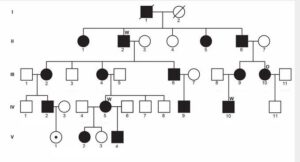Along with having some very talented scientists and engineers on staff, 23andMe is lucky to have some customers who are equally accomplished.

Dr. Ann Turner, MD
One of those is Dr. Ann Turner, a 23andMe Ancestry Ambassador and physician. Ann was recently listed as a co-author on a paper published by researchers from the University of Iowa about a genetic variant involved in hearing loss. It turned out to be in a gene that was not even known to be important for the sense of hearing.
“My main contribution was recruiting enough cousins to isolate the segment that must of necessity harbor the mutation,” said Ann.
What’s inspiring is that the impetus for this research was Ann’s own quest to learn about the genetics behind her and her family’s hearing impairment.
Her own hearing loss started in childhood and got progressively worse over time. She’s been wearing hearing aids for 40 years now. Worldwide hearing impairment impacts over five percent of the population, or about 360 million people. Although many different genetic mutations are involved in hearing loss, in this case the researchers were able to isolate a single mutation involved in this one family’s loss of hearing.
Ann’s own personal search of the genetics behind the trait included work going back more than 20 years. She used traditional genealogical techniques to trace hearing loss back 200 years in her family to an ancestor named John Riley, who was born in 1813. One of her relatives, James Riley, a Civil War veteran, died from a fall after failing to hear a warning from a co-worker that the scaffolding he was on was not secure.

This is a pedigree Ann did of her family showing how tracing the mutation through generations of her family.
Beyond paper records and family trees, Ann also used her and her cousins’ 23andMe results to try and track down the genetics behind their hearing condition. She participated in 23andMe’s exome pilot project a few years ago. This allowed her to obtain the sequence data for all the coding regions of all genes, and she was in turn able to use that data to point to candidate mutations possibly involved in her family’s hereditary hearing loss. “Even though this type of testing is not designed to discover rare or novel mutations, I could roughly narrow down the chromosomal region where the mutation must be located,” Ann said. By looking at her and her family member’s data she was able to identify places where only those with hearing loss shared DNA segments.
“It finally boiled down to just one region by the time all of our results were compared. I wrote about this in a blog post for 23andMe,” she said. The candidate mutation is in the HOMER2 gene. Following up on that work, researchers at the University of Iowa did what are called “functional studies” looking at how that specific genetic mutation affected zebrafish and mice in the lab. The researchers initially found that the loss of function of HOMER2 gene caused by this mutation led to changes in hair cells in the lateral line organ of the zebrafish, which detects movement in the surrounding water. In an email Ann sent to the family members who participated in the research she referenced what researchers did next in their study of mice.
“When (the researchers) did a “knockdown” of the HOMER2 gene (made it completely non-functional), the mice developed an early onset hearing loss. It was progressive and started in the high frequencies first, just like our family,” she told her family.
“Our data offer novel insights into gene pathways essential for normal auditory function and the maintenance of cochlear hair cells,” according to the paper’s authors. For Ann the finding was both illuminating for her own family’s condition, but also interesting from her point of view as a scientist. “I have a sense of wonder at how this study illustrates the unity of life, with changes in the lateral line organ in fish confirming the functional effect of the mutation,” she said. Ann adds that other families may be able to use 23andMe tests to help identify the cause of some genetic trait or condition.
For Ann the finding was both illuminating for her own family’s condition, but also interesting from her point of view as a scientist.
“I have a sense of wonder at how this study illustrates the unity of life, with changes in the lateral line organ in fish confirming the functional effect of the mutation,” she said. Ann adds that other families may be able to use 23andMe tests to help identify the cause of some genetic trait or condition.
The candidate mutation is in the HOMER2 gene. Following up on that work, researchers at the University of Iowa did what are called “functional studies” looking at how that specific genetic mutation affected zebrafish and mice in the lab. The researchers initially found that the loss of function of HOMER2 gene caused by this mutation led to changes in hair cells in the lateral line organ of the zebrafish, which detects movement in the surrounding water. In an email Ann sent to the family members who participated in the research she referenced what researchers did next in their study of mice.
“When (the researchers) did a “knockdown” of the HOMER2 gene (made it completely non-functional), the mice developed an early onset hearing loss. It was progressive and started in the high frequencies first, just like our family,” she told her family.



